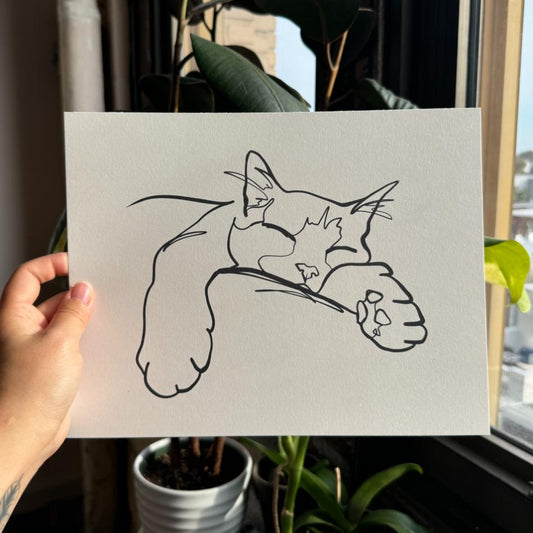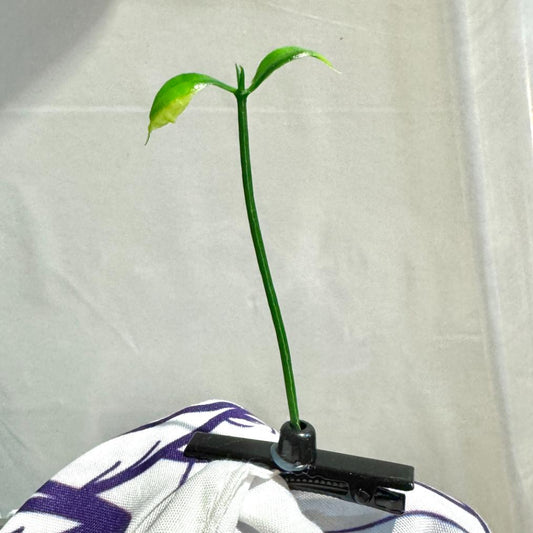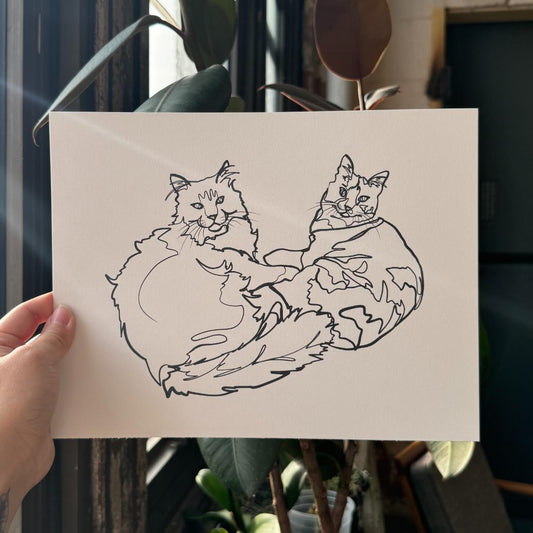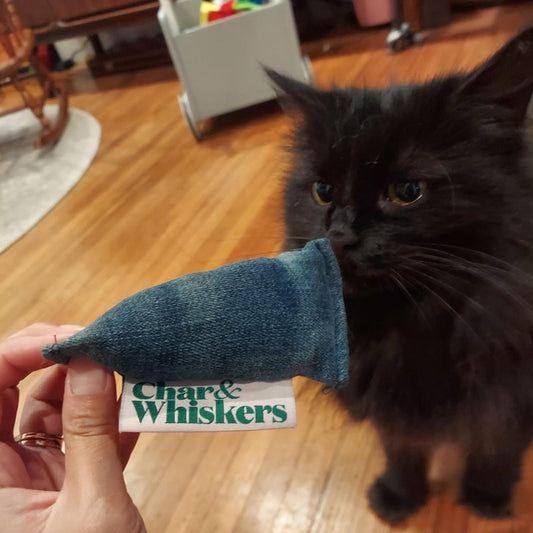
Introducing Cats: Making Sure My Cat Won’t Murder the New Kitten
Tiffany LiuWhen we think about giving our pets a sibling, we dream of a pet family and them being the best of friends. But everyone knows siblings don't always get along and that is especially so with cats. If you bring home a new sibling and make them share a room, bathroom, food and toys and expect kids or cats to get along right away, you are mistaken.
It is important to remember that cats are extremely territorial, so it’s hard to ask your cat to welcome a stranger into their home with loving paws after they’ve gotten used to being an only child. Thankfully, there are effective ways to introduce cats to each other that will reduce stress for you and the cats.
Here are the simple steps I took and insights I kept in mind that allowed for a smooth introduction of a new kitten to my older cat during their first weeks at home together that left no cat harmed.
The Preparation
Before the cats are even in the same home, you must prepare for your new tenant by clearing a space for it. The new cat needs to have a room or space to themselves where your older resident cat is unable to interact with it.
I set up a room in the spare bathroom and knowing how my resident cat felt about the neighborhood cats, I had to double insure the door.

My bathroom door had a gap beneath it that looked like the perfect space for paw fighting so I placed a cardboard box in front of it. The box would prevent contact but still allow scents to permeate throughout the house.
Adjust in and around the space as necessary to avoid injuries and keep both kitties safe. Then, fill the space with a water bowl, a bed, blankets, toys, and a litter box. Separate litter boxes are a must for each cat because using it is a way for them to mark their territory.
The First Days At Home
Introduce each cats’ scent to each other with their blankets, toys, rags, etc. Smell means a lot to cats so swapping belongings is a great starting point that allows their scents to mix and mingle.
I started with just letting them smell the items, then I rubbed toys and blankets with the other cat’s scent onto both of them and doing so allowed them to get used to being near each other without actually interacting.

Allow your resident cat to explore the kitten’s room while it is empty and at the same time allow the kitten to explore the rest of the house. They will poke and sniff around until there’s nothing new to poke and sniff at.
Don’t forget about your first born.
Pause!
The excitement of having a new kitten can overwhelm your attention to your resident cat. Observe your resident cat’s behavior closely as this can be a stressful time for them.
During the first few days my resident cat avoided the bathroom housing the kitten all together. Then the growling and hissing ensued which was my cue to bring him away from the door and give him attention.
Observe both cats’ body language. When they smell each other’s belongings are they hissing or growling? If your cats get too close to each other do you see puffed up fur and airplane ears? If any of these behaviors occur, the cats still need time getting used to the presence of one another before an official introduction. When their body language shows they are at ease, so relaxed posture, forward facing ears, and a tail that isn’t swishing angrily, then your cats are one step closer to meeting.
Always prioritize their emotions. Yes, we want them to be best friends and take videos of them grooming each other and napping together as soon as possible but they will let us know when they are ready to meet their companion.
The Interaction
After they become used to each other’s scents, find a way to have them look at each other. You can create a barrier with a gate, crack the door open, or hold them at a distance. I had a mesh playpen for the kitten where they could observe each other closely but still be apart.
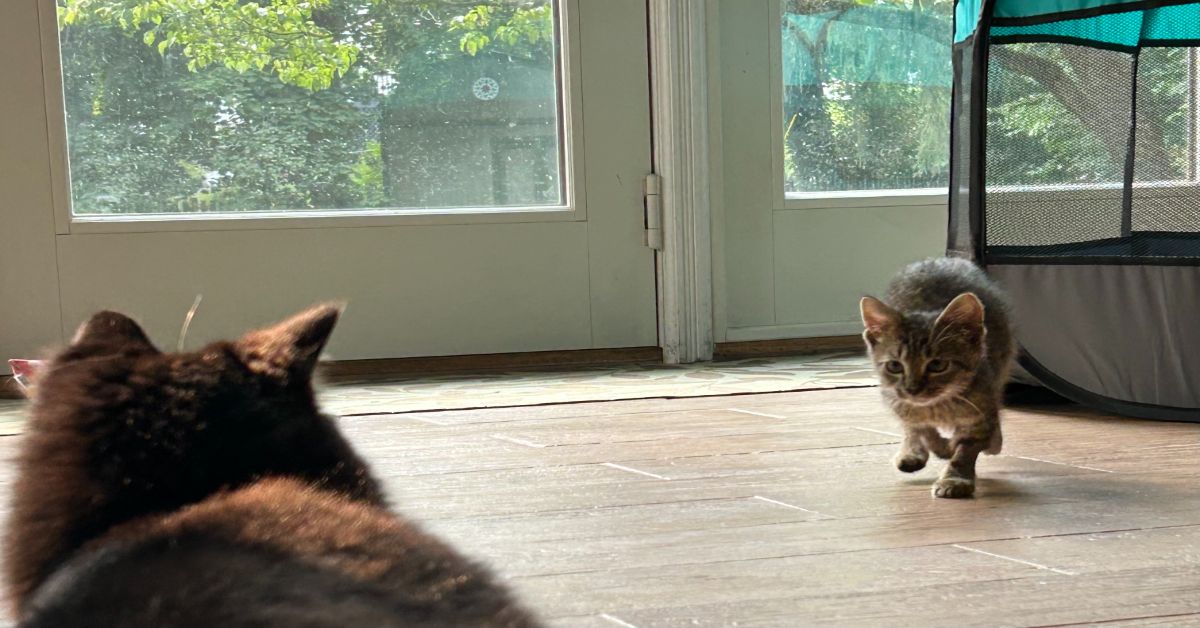
Now, get them used to actually sharing a space by keeping them occupied while they are in the same room. Feed them during this time or play with them, let them sniff each other and interact.
At this point, it is safe to let the cats interact under close supervision. Continue to occupy them by letting them play with toys, play with each other, eat, etc.
The Best Friends (?)
By now they should be used to sharing a space but that doesn’t always mean you are free to let your cats do anything they want. When the cats were just play fighting, the obvious strength differences between a kitten and an adult cat proved to be concerning at times so I would have to separate them again. And play fighting can quickly turn into a real fight for seemingly no reason so always keep a close eye on them.
It is safe to say my cats now peacefully coexist. I am still careful, I have shooed the kitten away from my older cat’s litter box and food bowl multiple times, delaying fights. But, they play together, take naps, watch birds, and are filling up my phone’s camera roll with their activities.

Why it worked
Understanding their nature: I allowed each cat to feel comfortable in their own space with the knowledge that their spaces are essentially being invaded by another cat. As territorial beings, they need plenty of time to adjust to sharing a space with a new cat.
Patience: It took about 3 weeks for the cats to get to the point they are at now and it may take shorter or longer depending on your cats. I paid attention to each cat’s body language while taking small steps that would help them get used to the other’s presence.
Remember to take your time and have fun raising your fur babies together!

